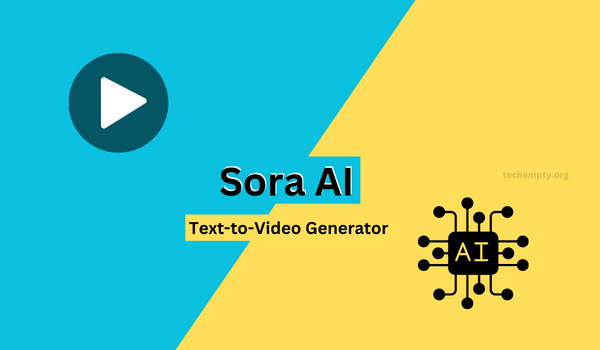We are seeing a huge leap forward in AI video generation with OpenAI’s new Sora model. This amazing text-to-video generator can create very realistic and imaginative video scenes up to 60 seconds long. It only needs text prompts to do this.
Sora AI text-to-video generator is a big step towards more general artificial intelligence. It can understand and generate free-form video just like humans can imagine and see dynamic scenes in our minds. Let’s explore how this fascinating technology works, what it can do, where it still has limitations, and what the future may hold for AI-generated video content.
Start from here..
How Sora AI Video Generator Works?
Sora combines two cutting-edge machine-learning techniques: diffusion models and transformer architecture. It has been trained on a huge dataset of video clips paired with matching text descriptions. This helps it learn the connections between language and visual concepts.
Sora AI takes in text prompts and breaks them down into keywords, entities, actions, emotions, scenes, camera angles, character details, and more. It develops a rich latent representation capturing all these elements. Then it uses generative diffusion models to translate that latent space into clear video frames with fine detail.
This allows Sora to interpret very complex prompts, determine the essential meanings, resolve unclear language, and fill in any gaps using its intelligence. It produces videos that accurately show what the text describes.

Key Features of the Sora Video AI Model
Sora has shown some awe-inspiring capabilities in demos and samples shared by OpenAI researchers. The AI-generated videos feature:
- High visual quality – Sharp, vibrant imagery with accurate lighting, shadows, reflections, and other details that look photorealistic
- Complex multi-character scenes – Several characters independently move, gesture, and interact within the frame
- Specific motions and actions – Characters performing precisely described motions, like dancing in a particular style
- Consistency across shots – The same backgrounds, characters, appearance, motions, and style maintained across different camera angles and cuts
Sora AI can also extend existing video clips by consistently generating plausible subsequent frames. This could fill in missing sections or extrapolate videos forward or backward through time.
Potential Use Cases for Sora AI Video Generator
It’s not hard to imagine the massive implications such a sophisticated video AI could have across many industries:
- Filmmakers and animators can exponentially increase their productivity with automatically generated storyboards, background scenes, character motions, and more to speed up video creation.
- Educators can bring history and science to life through AI-generated reenactments and simulations that would previously require massive Hollywood-sized budgets to produce.
- Game developers can craft infinitely varied cutscenes with dynamic characters that react appropriately to users’ gameplay actions.
- Marketers can instantly produce hundreds of personalized, attention-grabbing video ads tailored to different customer segments, campaigns, and contexts.
Those are just a few of the most obvious applications – creative professionals in every field will likely find invaluable assistance from Sora and its inevitable future versions.
Current Limitations of Sora Video AI
As remarkable as Sora is, as with any new technology, there are still noticeable limitations in what it can simulate compared to human-created video footage:
- The model may have trouble accurately rendering tricky physics like liquid or smoke flows. Complex cause-and-effect chains can also challenge Sora’s reasoning capabilities.
- There can be spatial inconsistencies between shots – objects or characters shifting location slightly rather than maintaining absolute precision across different framings.
- The timing of motions and events sometimes contains small awkward pauses or continuity gaps. Syncing character lips to dialogue also needs more work.
Of course, Sora AI is still very early and without extensive real-world testing and feedback. We expect its capabilities to evolve rapidly with additional training data and algorithmic improvements.
How to Get Sora AI Access?
Eager creators have likely already asked themselves – how can I get my hands on Sora to start experimenting? or for the Sora release date.
Unfortunately, Sora’s access is currently tightly restricted. OpenAI has not yet specified whether or when Sora will be publicly available. Source
For now, access is limited to hand-picked “red teamers” – experts charged with poking holes in Sora’s capabilities to expose harmful failure modes and biases needing correction before broader release.
A few filmmakers, animators, and other artists have also been granted access to provide creative feedback, but public registration does not exist yet.
Comparing Sora to Other AI Video Generators
How does Sora stack up against competitors in the red-hot AI video generation space? There are a few other names making waves.
Meta recently unveiled Make-A-Video, which can generate short five-second video clips from text prompts. Google Brain also announced a similar model called Lumiere back in 2022.
Compared to tools like Make-A-Video and Lumiere, Sora truly stands out for its 60-second maximum length and photorealistic quality.
Where Meta’s model focuses on faces and portrait shots, Sora AI can render full scenes with environments, multiple characters, distinct actions, and camera movement. This makes it better for more cinematic, narrative videos.
Generative video startups like DeepBrain AI also concentrate narrowly on creating very realistic AI avatars for dialogue situations.
Sora takes on the complex challenge of turning unstructured text into video footage representing the full complexity described.
Of course, as none of these models are publicly accessible yet, comparisons are still conceptual. But Sora appears poised to set the new high-water mark for text-to-video AI capabilities.
The Future Outlook for Sora and AI-Generated Video
What could the future look like as text-to-video models like Sora AI mature and spread?
Most industry experts predict capabilities will continue to advance rapidly even as research and development remain private.
So, sadly, no precise timeline exists for when Sora specifically might become more widely usable – it could be months or even years as teams carefully evaluate ethical risks.
But despite uncertainties around release plans, Sora moves us much closer to artificial general intelligence that can match human imagination.
OpenAI CEO Sam Altman says we are witnessing “AI systems [achieving] at an abstract level what humans uniquely can…see things in our mind’s eye.” Source
With exponential progress towards this lofty goal, video content creation seems poised for a revolution – perhaps surpassing all other generative AI breakthroughs.
Yet these seismic technological shifts also bring understandable societal concerns and questions.
What happens to creative professions when realistic video can be made on demand? Who is responsible if AI-generated content causes harm? Can we develop compassionate, ethical frameworks for such potentially disruptive advances?
The path ahead will require sustained reasonable faith efforts from all stakeholders – researchers, lawmakers, domain experts, and everyday citizens. Responsible development and deployment of technologies like Sora will be critical as the AI revolution speeds up through this decade and beyond. We all have a role in steering this towards positive progress and improving life.

